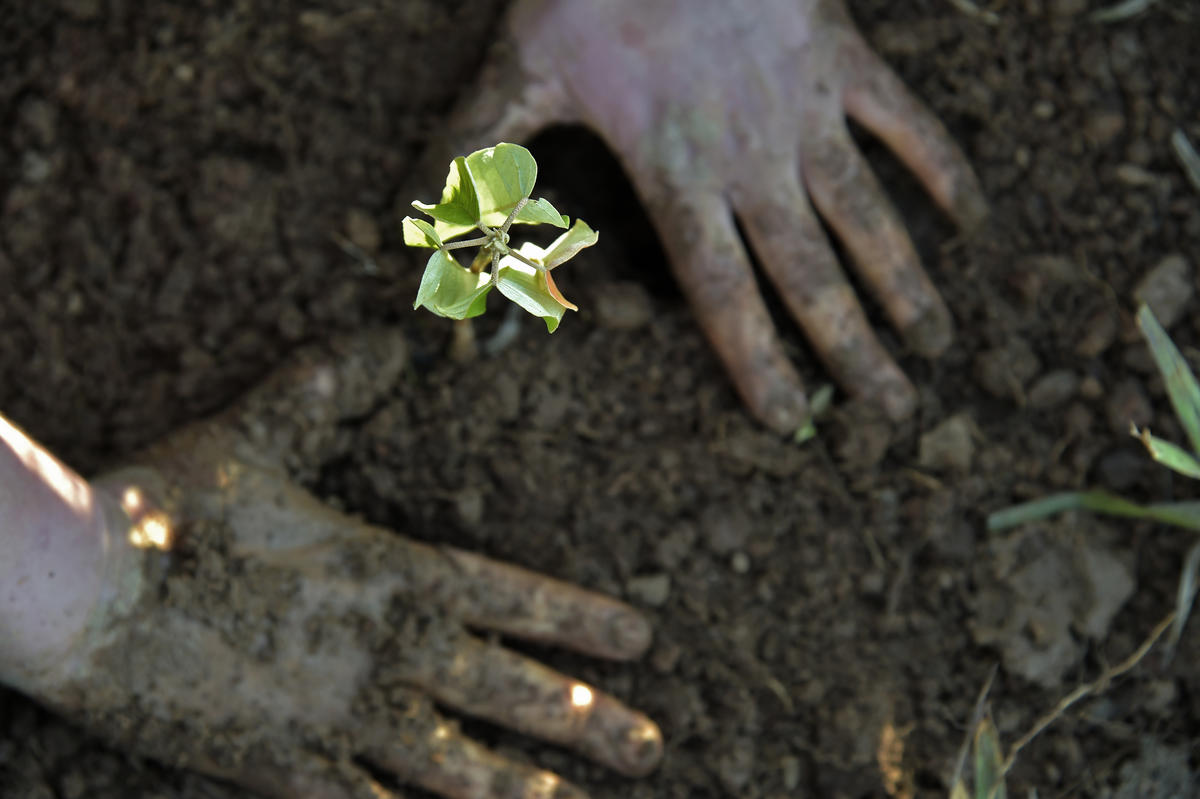
Photo: A farm manager shows nitrogen-fixing roots in a plant growing on a plot near Santa Fe, Argentina. World Soil Day is a reminder of how techniques such as carbon capture can help the quality and structure of soils across the globe. Photo courtesy of Jason Houston/WWF-US.
Healthy soils are the foundation for much of life on earth; it is the living skin of the planet. But soil is in peril—and so are we. With World Soil Day occurring tomorrow, Dec. 5, it’s worth taking time to consider the unsustainable weight we are putting on the ground beneath our feet. More than 95 percent of global food production depends on soil. Yet one-third of the earth’s soils are already degraded, with over 90 percent headed in that direction by 2050, according to the U.N. Food and Agriculture Organization (FAO). That is bad news for agriculture, biodiversity and human health.
Why World Soil Day matters to global business
It’s also bad news for business. While soil erosion has a direct impact on farmers, it also has impacts across other sectors and implications for overall environment and health including water quality, the energy sector, urban infrastructure and our landscapes.
As Melissa D. Ho, Senior Vice President, Freshwater and Food, World Wildlife Fund, told TriplePundit, “Even if a particular business is not directly related to agriculture, every business depends on the services that soil provides. If you rely on wood products, access to clean water, infrastructure and energy, or — at very least — a healthy workforce and consumer base, you need soil.”
Soil does a lot of mostly unnoticed work for the planet, she added. “We tend to overlook the biodiversity that the soil provides — billions of microorganisms that play an outsized function in our ecosystems, including nutrient cycling and nitrogen fixation. Healthy soils and landscapes also play a critical role in maintaining freshwater ecosystems — soils buffer extreme water events, whether floods or droughts, and they also buffer pollution to protect our important sources of freshwater and groundwater.”
It may not seem like it looking down, but soil is under siege
Unfortunately, World Soil Day reminds us how soil is under pressure from deforestation, overgrazing, plowing and unsustainable agricultural practices — and that comes with a price tag. Soil erosion contributing to reduced crop yields and increased water usage is estimated to cost $8 billion globally each year, according to the European Union Joint Research Centre. As a result of soil erosion, food production is reduced by 33.7 millions tons of food worldwide.
That is a cost society can ill afford, with a world of some 9.7 billion people by 2050 that need to be fed and growing food insecurity exacerbated by the COVID-19 pandemic.
Ho sketched out what we’re up against. As she explained, since the Industrial Revolution, human agriculture is the single largest source of soil exploitation and degradation. Today, about 40 percent of arable land is used for cropping and grazing for food production. Soil erosion can lead up to 50 percent loss in crop yields and has already been shown to reduce productivity of existing agricultural lands. Soil erosion on arable or intensively grazed lands are up to 1,000 times higher than natural erosion rates.
“We are losing our soil faster than it is being replenished by nature,” Ho said.
Ho ticked off the problems that occur when that happens: decreased agricultural productivity, degraded ecosystem functions, amplified water-related risk such as landslides or floods, significant losses in biodiversity, damage to urban infrastructure and, in severe cases, displacement of human populations.
Risks associated with soil health aren’t shared equally across the globe
A report from the European Commission earlier this year found that the Global South would bear the brunt of the erosion. Rich countries with high fertilizer use and moderate climates can expect erosion at a lower rate.
Without additional efforts to protect soil, this erosion would make reaching the U.N. Sustainable Development Goals (SDGs), including the target of land degradation neutrality by 2030 and the elimination of hunger, much more difficult.
The European Commission will adopt a new Soil Strategy in 2021 to address these issues in a more comprehensive way and to fulfill EU and international commitments on land degradation neutrality. The European Green Deal, targeting carbon neutrality by 2050, should also mitigate soil erosion indirectly, thanks to its positive effect on the water cycle.
New research also suggests that climate change is a major driver of the change in soil erosion and could increase average soil erosion by 30 percent to 66 percent depending on the intensity of warming predictions, due in large part because of more extreme weather and rainfall events.

Ho explained, “There are negative feedback loops between negative impacts of climate change on agriculture and ecosystems, which will in turn only exacerbate human impact on climate and nature.”
Because of its role in carbon sequestration and storage, and the potential role of soils for mitigating climate change, along with all the other roles it plays in a healthy planet and society, “soil is getting a lot of attention lately,” she said.
For those who put their hands in the dirt as their livelihood — farmers and ranchers — soil is never far from their minds, Erin Fitzgerald, CEO of the U.S. Farmers and Ranchers in Action, told 3P. USFRA recently convened a broad multi-stakeholder dialogue across the food and agriculture sector to come up with a new vision for a more sustainable agriculture system.
“World Soil Day reminds us that every farmer and every acre has the potential to unlock carbon solutions for the future,” Fitzgerald said. “The agriculture sector is often undervalued for its potential to enable the world to transition to a net-zero economy.”
Don't underestimate soil's role as a carbon sink
A 2019 report from USFRA on agriculture’s role in ecosystem services found that current soil stocks in the U.S. store as much carbon as about 123 billion cars driven for a year, nearly equivalent to the current cars to be driven in America for the next 150 years. Climate-smart practices could reduce the agriculture sector’s GHG emissions between 46 percent and 147 percent.
WWF’s Ho agreed that there is untapped potential for protecting soil in climate-smart farming practices — one that must be remembered long after today’s World Soil Day.
“Producers know that they must ensure long-term viability of their fundamental asset: the soil," Ho said. "Heathy soil is the foundation for their productivity, profitability and sustainability of their agro-ecosystem. Practices that maintain ground cover and living roots and foster healthy soil organisms and organic matter are important for protecting soil, as well as practices that keep soil structure intact and minimize mechanical disturbance and compaction."
Agricultural practices that help keep soil healthy include reduced or no-till farming; cover cropping; crop rotation; reduced chemical inputs, especially pesticides and herbicides; and management of nutrients and organic matter.
What can World Soil Day motivate us to do going forward?
It's no wonder that even before World Soil Day appeared annually on the calendar, soil health is fast becoming one of the hottest trends in the food and farming industries, according to AgFunderNews. Ag and foodtech startups like biocarbon producer Cool Planet, microbiome tester Trace Genomics and bioinformatics startup Biome Markers are among them.
Paying attention to soil is about grasping opportunities, but it’s also simple risk management, according to the World Business Council for Sustainable Development’s “Business Case for Investing in Soil Health,” which pointed out that soils play a crucial role in two of the top business risks: water crises and climate change.
“If we are to have sustainable businesses, economies and societies, they will be built on healthy soils,” the report concluded.
Image credits: WWF

Based in Florida, Amy has covered sustainability for over 25 years, including for TriplePundit, Reuters Sustainable Business and Ethical Corporation Magazine. She also writes sustainability reports and thought leadership for companies. She is the ghostwriter for Sustainability Leadership: A Swedish Approach to Transforming Your Company, Industry and the World. Connect with Amy on LinkedIn and her Substack newsletter focused on gray divorce, caregiving and other cultural topics.














